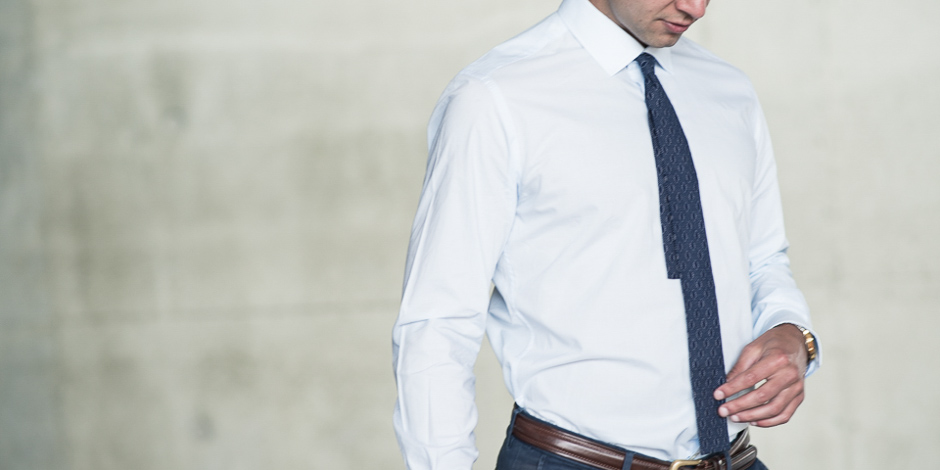If our outfits were a sentence, our shirts would be the subject. Our shirt can dictate the rest of our outfit based on its color and cut. Shirts also frame our face and define our silhouette, so it’s critical that they fit properly. A shirt that doesn’t fit properly will make us look larger than we are. If it’s too big it will create a “muffin top” around our waist and make our sleeves billow like a pirate’s. If it’s too small it will highlight every bulge and curve on our bodies and restrict our arm movement. And keep in mind, very few store-bought shirts will fit us perfectly. Mass-produced shirts are made to mostly fit most people and a perfect fit likely won’t be found without the help of a tailor.
Collar
With the collar buttoned, our shirts should afford us enough room to breathe without making us look like we’re wearing our father’s shirt. We should be able to fit a finger or two between our neck and the collar of the shirt. The collar is one of the basic measurements of men’s dress shirts (the other being sleeve length). When we find a shirt that fits us well around the neck, we should remember the measurement for future purchases.

Shoulder
The seam where the sleeve meets the shoulder should rest at the end of our shoulder. This part of the shirt is inalterable and cannot be changed by a tailor, so we should always make sure this seam sits on the very end of our shoulder. If the shoulder seams sit too high or too low on our shoulders, it will impede the range of motion of our arms. [And you’ll look silly.]

Sleeve
The other measurement found on most store-bought dress shirts is the sleeve length and also should be remembered. With our arms at our sides, the cuff of the sleeve should fall to the base of the wrist. Too much farther and we look like a child. Too much higher and we look like we’re wearing our shirt from high school.

Cuff
Regardless of the style of cuff on our shirt, it should be loose enough not to trap a watch on the inside or outside of the shirt. It should also be tight enough that taking the shirt off without unbuttoning it is difficult. If our cuffs are too big we run into the dad-shirt problem. If they’re too small, we won’t even be able to button them.

Body
The fit of the body of the shirt leaves more room for personal taste, but a good rule to follow is we shouldn’t be able to pinch more than three inches (or seven centimeters) of fabric away from our body. Any more than that and the shirt will balloon out around the waist. Likewise, our buttons shouldn’t be struggling to hold our shirts closed. This shortens the life of our buttons and makes us look overweight.

Length
Dress shirts are meant to be tucked in so it’s important that they are the right length. If our shirts are too short, they’ll come untucked when we sit down or stretch. If they’re too long our shirts will bunch up in our pants, making us look like we don’t know how to dress ourselves. Ideally, the front of the shirt should extend no lower than the bottom of our fly and the back should come down to the bottom of our butts.
All of this might seem a bit overwhelming if we’re new to fashion but if our shirt doesn’t fit right, we know it. As I said earlier, no store-bought shirt is going to fit us perfectly in all of these areas but when trying it on, try it out. We should twist our necks, shrug our shoulders, and reach with our arms. Looking good is important, but we don’t have to sacrifice feeling good to achieve it. Remember, all of our work can be undone by a sloppy job tucking our shirts in. If we take the time to do it neatly, we’ll be fine.
Resources used in this article
https://www.hughandcrye.com/pages/better-fitting-dress-shirts
http://www.realmenrealstyle.com/proper-dress-shirt-fit/
http://www.artofmanliness.com/2009/04/12/understanding-the-dress-shirt-custom-shirt-giveaway/
